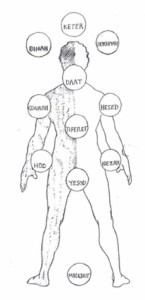Drash Cards for Tazria-Metzora (5776)
By Marc Mangel
• I decided to focus on the triennial portion that we read, the end of Tazria (dealing with the last identification of tzaraat) and the start of Metzora (the beginning of the explanation of purification).
- About these parshiot, R. Nachsoni wrote that because almost all of the commentators sought symbolic interpretation, this “proves that the basis of this parashah is not to be found in the plain meaning, but is in nistar, as revealed by the masters of Kabbalah”.
- So, I turned to my source for practical Kabbalah, Chabad Chasidut.
• A reminder. The sefirot are aligned with the body. Chesed and netzach on the right side flowing inward, Gevurah and hod on the left side flowing inward and both toward tiferet, daat, keter, chochma and bina above them, and yesod and malchut below.
- First, the cause of tzara’at. In the Rebbe’s Chumash we read that tzara’at is not from any natural physiological condition, but is the obstruction of the flow of divine energy from chochmah to binah (across your mind)
- And that tzara’at is also caused by an imbalance between chesed and gevurah (across your heart).
- And that it is an imbalance between the rapturous desire to experience Divinity (ratzo) and the associated devotion to doing the mitzvoth (shov): “favoring one propensity over the other – rapture (ratzo) over devotion (shov) or vice versa – upsets the balance in the soul”
- That is — Tzraa’at is caused by a block of the flow between the sefirot, thus leading to an imbalance.
- If you went to an acupuncturist – a practitioner of another ancient tradition — he or she would also talk about blockages of the flow of energy – but call it qi rather than the sefirot
- Next the cure. In the Rebbe’s chumash, we read “The cure for tzaraat is the harmonization of the opposing drives. To do this, a third force which transcends them both must be invoked.”
- There are two components to the cure. First, the metzora is isolated outside of the community – separated from it – as a means for the person to begin thinking about the actions that caused this and to do teshuvah.
- The second part of the cure is to bring a sacrifice. But there is a sliding scale to the sacrifices — a poor person need not bring what a wealthy one does. Bringin sacrifices is not a punishment but intended to bring one into focus.
- Today we might call both of these — separation and focus — mindfulness.
- I cannot leave this portion without discussing the connection between lashon ha ra and tzaraat (a proof text being BaMidbar 12:1-16 when Miriam is afflicted because of speaking against Moses behind his back)
- How can speaking make one ill? We all know the phrase ‘worried sick’ and have most likely experienced it ourselves – a worry (real or imagined) that was so strong that we became physically ill.
- Pinchas Peli notes that “Metzora sounds just like motrzi-ra — ie one who utters evil with his mouth”. So the speaking of evil with your mouth can make you ill, just as worry can.
- In summary, tzaraat is psychosomatic in the true sense of the word – connecting the spirit and the body
